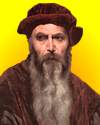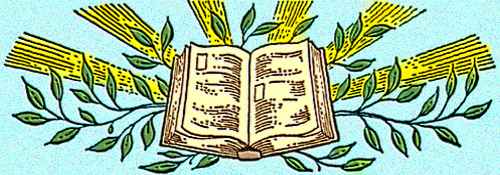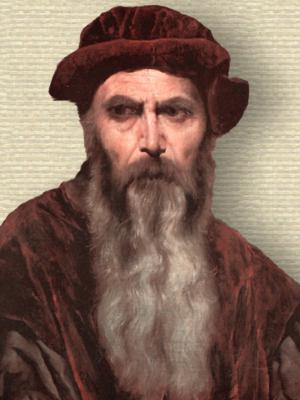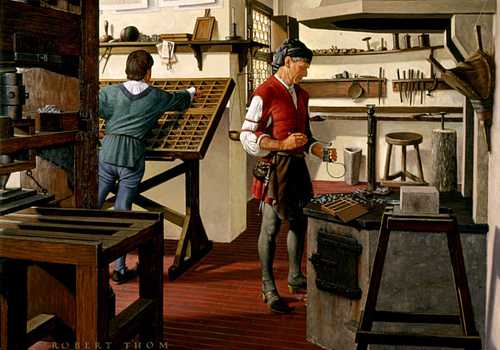 (source)
(source)
|
Johannes Gutenberg
(c. 1396 - 3 Feb 1468)
German inventor and printer who invented movable type, a new type-metal alloy, a new press, and an oil based printing ink.
|
Johann Gutenberg
from Life Stories of the Great Inventors (1948)
by Henry Thomas and Dana Lee Thomas
1398 ? — 1468 ?

[p.3] The idea of printing from clay tablets and from wooden blocks dates back to the pre-Christian era. It was known probably to the Assyrians about 700 B.C., and certainly to the Chinese about 50 B.C. But the invention of printing from movable type—that is, from the rearrangement of single letters and characters into various words—is only 500 years old.
And when the modern art of printing was first introduced to the world (about 1450), many a pious soul was astounded and shocked at the “Devil’s work.” A Parisian bookseller who sold two printed copies of the Latin Grammar of Donatus was thrown into jail as a Devil’s disciple. “For only a dealer in the black art can produce two copies that are exactly alike.”
II
There were those who credited the invention of printing not to Johann Gutenberg but to Laurens Coster, a native of Haarlem in the Netherlands. Coster was said to have printed (in 1423) sentences from letters carved out of beech-bark, and to have [p.4] subsequently replaced his wooden type with letters of lead and of pewter. This claim, however, is now generally disregarded; for there is in existence today not a single printed document that can be ascribed to Coster. Johann Gutenberg is almost universally recognized as the father of the “magic art of winged words.”
Johann Gutenberg came of a patrician family whose surname was Gensfleisch. They adopted the name Gutenberg from the estate on which they lived. Johann’s father, Friele zum Gutenberg, was the treasurer of the city of Mainz. This city had once enjoyed a reputation as a prosperous trading center on the Rhine. But the Black Plague, added to the incessant quarrels between the patricians and the guilds, had reduced the city to a down-at-the-heel township of 6,000 souls. In such a community the Gutenbergs, though far from wealthy, were regarded with envy by the even poorer members of the various guilds. And these poorer citizens were ever on the watch to dispossess “the rich” and to take over the government of the city for themselves.
It was in this atmosphere that Johann spent the early days of his life. A grounding in Latin at school, a training at home to stay away from the workers and the other “riff-raff” of the town, and a thorough indoctrination in the commandments of the Holy Book—these, in the main, formed the substance of his childhood education.
These, and two other important influences—the inconvenience of waiting for his textbooks, and the pleasure of playing with his picture blocks.
For in those days the textbooks, like all other publications, had to be copied by hand. A long and laborious and expensive job. Education was not only costly, but slow. And a pupil with a nimble mind like Gutenberg’s found it tedious to wait for a new book when he had mastered the old.
To while away the time, he played with the picture blocks at his home. His father had sent to Italy for these blocks—pictures carved out of wood and impressed, by means of ink, on [p.5] parchment or paper. Figures of kings and queens and knaves for playing-cards, and representations of episodes and scenes from the Bible. As he looked at his Biblical pictures, an interesting idea occurred to him. Why not collect a number of these pictures, and sew them together into a book? And then print, from the same blocks, another set of pictures and another and another, and bind every set of pictures into a separate book?
As he grew older, the idea of printing a book from picture-blocks developed into a more elaborate idea—to print a book from word-blocks. One day, as he watched a scribe copying his Donatus grammar, he said: “I think you could save time, Sir, if you would carve the pages of this book into blocks, like pictures, instead of copying them out on parchment.”
“But I’m not a carver, my son. I’m a writer . . . Besides, I’m a great believer in tradition. What was good enough for my ancestors is good enough for me.”
Shortly after this interview, Johann startled his father with a request to apprentice him to a wood-carver. “But carving is a trade for the lower classes, Johann. Don’t forget that you are a patrician!”
A youngster with strange ideas and a stubborn mind. “God meant the patricians, too, to work with their hands.” Perhaps the child was right. The way things were going in the topsy-turvy world of 1415, many a Mainz patrician might soon be reduced to the indignity of working for a livelihood. Perhaps a refined sort of occupation mightn’t be such a bad idea for Johann. Not wood-carving, however. Too much like carpentry—a trade suited only to the calloused sensibilities of the mob . . .
And then an idea struck Friele Gutenberg. If the boy insisted on carving, let him work in the medium of silver and gold. Aristocratic metals for a patrician child. And so he apprenticed Johann to the engraver at the city mint. Right close to the treasury, where he himself was employed, and where he could keep an eye on the youngster.
[p.6] Johann liked the work. It was even better than carving on wood-blocks. The figures and the letters were smaller, and the engraver’s touch had to be ever so much more delicate. The minting of money was merely the printing of pictures in miniature. First, the design for one of the sides of the coin was modeled in wax by an artist. And then the engraver chiseled the design into a piece of soft steel, hammered the lettering of the coin into the edge of the steel, and hardened the die of the soft metal by heating it in a flame.
In the meantime, the design and the die for the other side of the coin were prepared in exactly the same way.
And now the workers were ready for the stamping of the coin. They placed a disc of the precious metal between the two dies— a sandwich of silver or gold between two slices of steel—laid the “sandwich” down under a hammer, and pounded the dies together until their lettering and design became imprinted upon the coin.
Only a few letters on either side, and only a small design. So much neater than the page-long combination of pictures and words that were carved out in the unwieldy wood-blocks of the playing-cards.
The selfsame continuous succession of pictures and words— bound always together in the solid block and never allowed to be separated . . . Suppose you wanted to substitute one word for another, or to rearrange the design. It just couldn’t be done. The block was a single unit.
But so was the coin, a single unit. Yet there were only a few letters on the coin. What if you had only a few letters on a block, and another block with only a few letters, and still another? Or still better—strange that nobody had ever thought of it before him!—what if you had only a single letter on each block? Then you could carve out these letters on as many blocks as you needed for the printing of a sentence—a page—an entire book!
This idea became indelibly impressed upon his mind as he [p.7] kept working at the mint. When he came home at night, he began to experiment with the idea on little squares of wood. Single letters for each square, and several sets of letters for the entire alphabet. What a fascinating game, arranging these individual letters into all sorts of word-combinations!
But what a laborious job, cutting out all these letters over and over again! Not only laborious, but—from a practical standpoint —almost useless. For the wood kept splintering and splitting as you tried to impress the letters upon sheets of paper. You could avoid this breaking of the type, of course, if you carved the letters out of metal instead of wood. But what a job that would be!
And then a simpler solution to the problem occurred to him. One day he was watching a jeweler at his work. The man was reproducing a metal brooch. A most interesting process. The jeweler opened a casting-box, filled the two halves with fine damp sand, placed the original brooch on the surface of the sand in one half of the box and then shut the other half tightly down upon the first. In this way, an exact impression of the brooch was hollowed out in the damp sand. He now took out the brooch, poured melted metal into the hollow impression in the sand, and thus fashioned an exact duplicate of the original model.
As Gutenberg watched this operation, he realized that he could do with model letters just what this jeweler was doing with a model brooch. Instead of carving separate wood-blocks for all the repetitions of the various letters, he would make one block for each letter and then sand-cast all the duplications of these letters, in metal type.
And this is how the invention of printing came about.
III
But the idea was still in its embryonic stage. In order to perfect himself in the art of shaping small and delicately-rounded objects, like the letters of the alphabet, he went to work for the jeweler.
[p.8] He became an expert in the cutting and the polishing of precious stones.
A few years of this delicate carving in jewels, and then his work was unexpectedly interrupted. The guild members of Mainz had rebelled against the patricians and had taken over the government. They passed “defensive” laws against the “idle rich” and expelled a number of their ringleaders from the city. Among those exiled was Johann Gutenberg.
Thirty years old now, and almost penniless. He threw his few belongings into a bundle and moved to the more hospitable city of Strasbourg, about a hundred miles away.
Here he found work in his chosen field of jewel-cutting and devoted his evenings to his experiments in the carving and the casting of movable type.
In order to defray the expenses of his experiments, he tried to collect his share of the Gutenberg property—his parents were now dead—from the Mainz officials who had confiscated it. But in vain. They had the law on their side, because it was they who made and administered the law. And so he was obliged to work on, with insufficient funds and a bitter heart.
But there were friends in the city who gave him their moral if not their financial support. One of these inspiring friends was the Bishop of Strasbourg. They were building the cathedral at the time. A long and costly and often discouraging job. Yet the bishop had an undying faith in the success of the enterprise. “We will go on with the building, stone by stone, and prayer by prayer, until the uppermost of the towers has reached into the sky.” He, too, Johann realized, was building a cathedral for the future. A monument of human aspiration based upon the printed word. And he too, God willing, would persist in spite of all obstructions until the work was done.
And the obstructions came in upon him thick and fast. A love affair with an aristocratic young lady, a quarrel when he refused to give up his “crazy invention” for her sake, and a lawsuit [p.9] against him for breach of promise. He won the case—and found himself almost immediately involved in a maze of other lawsuits. One of these was against the city clerk of Mainz, who was visiting Strasbourg and who was arrested at Gutenberg’s demand. “I’ll release the .prisoner if he will promise to release my funds.” The city clerk readily gave his promise—and as readily forgot it when he returned home. At about the same time, Gutenberg was sued by a cobbler, Schotten Lawel, for “defamation of character” because, when the cobbler had testified against him in his breach of promise trial, Gutenberg had called him a liar. Gutenberg lost the case and was compelled to pay a fine.
A stormy character, whose slender funds were being constantly dissipated by the storm. Yet he kept doggedly on with his dream. He found three partners who offered to supply him with capital for the establishment of a printing shop. One of the partners died, and the others tried to steal Gutenberg’s ideas and his press. Another lawsuit—long and anxious days of hunger and dejection and despair—and finally the courts decided in his favor. But the influential citizens of Strasbourg had decided against him. Who was this “foreigner” who had brought so much disturbance into their midst? One of the defendants in his lawsuit against the stealing of his invention was the sheriff of Strasbourg. How dared a “mere Maintzer” to accuse a “respectable Strasbourger” of dishonesty? Let the trouble-maker get out of their city, they insisted. And let him get back where he belonged.
A good opportunity to return to Mainz. There had been another revolution in that city, and the patricians were again in the saddle. He came home with renewed energy, but with no prospect of recovering his confiscated estate. It had been frittered away in his everlasting lawsuits to regain it, until now there was nothing left.
He formed another partnership to set up a printing shop. His new partner, a goldsmith by the name of Johann Fust, offered to [p.10] finance the printing of the Donatus grammar and, later, of a much more ambitious work—the Bible.
“Before we undertake the Holy Book,” Gutenberg cautioned his partner, “I shall have to make many improvements in my type. We must have nothing but the best for the word of God.”
“You are right,” said Fust. “Perfection above all. I have the money, so we can both afford the patience.”
Again Gutenberg trusted a friend—only to be doomed to disappointment again.
IV
The printing of the Donatus was a great success. This Latin grammar was being used in many schools throughout Europe; and within a short time, the little book of twenty-eight pages went into fifteen editions.
But the printing of the Bible was quite another matter. It was to be a book of a thousand pages, two columns to a page—a colossal expenditure of time and money and metal and type. And the designing and the casting of the type had to be constantly improved so as to stand up against the wear and tear of the presses and to offer a uniform and even impression upon the page. At first he cut each letter out of a piece of wood, molded it in brass by the sand-casting method, touched it up to an equal height with the other letters, and “punched” it with a hammer into a piece of lead until the lead received a clear impression of the letter. This “impressed” piece of lead became the “matrix”—or “mother”—of all the duplicate copies of the letter that were to be cast in it. As time went on, however, he gradually discarded the wood-carving and the sand-casting process. Instead, he now carved the letter directly out of soft steel, then alternately heated and plunged the steel into cold water until it became hard enough to be used as a punch. And then, by dint of still further experimentation, he discovered that the letter of tempered steel could [p.11] be hammered into a metal that was harder than lead. And so he changed the “mother-metal”—that is, the matrix—from lead to copper.
And thus, trying to perfect the vehicle for “the divine message of God,” he exhausted the human patience of his partner. It was now two years after the formation of their partnership, and Gutenberg had nothing more substantial to show than a heap of discarded type-models. “When are you going to show me some real results?” asked the irate goldsmith.
“In God’s good time, my friend.”
“Yes, but not in my time, it would seem. Nor in your time, either.”
Another year passed, and no apparent progress. Gutenberg’s partner was furious. “I can do better myself, hiring my own men and superintending my own ideas.” And so, disregarding the fact that the original idea of printing was not his but Gutenberg’s, he confiscated the machinery that Gutenberg had made, stole his invention and, adding insult to injury, sued the inventor for all the money invested in the enterprise to date.
Gutenberg was now fifty-six years old. When he received the summons to the court, he almost collapsed.
At the trial he pointed out the many difficulties that had occasioned the delays in the printing of the Bible. But, in the ears of the judges, the voice of Gutenberg had a less persuasive sound than the jingle of coin. They decided that Johann Fust had invested his money in the expectation of an early return, and that he had a legal right to the fulfilment of his expectation. They therefore issued an order that the shop, with all its equipment, belonged to Fust, and that Gutenberg had no legal claim either to his ideas or to his work.
A dispossessed and penniless outcast on the threshold of old age.
V
[p.12] Johann Fust and his associates completed the printing of the Bible, with not a word of credit to Gutenberg for the invention that had made the printing possible. As a bitter sequel to the whole business, Gutenberg received a letter of congratulations from the Bishop of Strasbourg who, having seen a copy of the Bible, had concluded that it was the publication of his friend. “I thank the Lord for having guided you to the realization of your dream.”
Gutenberg smiled. A dream turned into a nightmare, so far as his own fortunes were concerned . . .
But Gutenberg was a fighter, even now that his strength was almost gone. He scraped together a few gulden, opened a little shop, sent for the type he had stored away in Strasbourg, and set to work printing a Bible of his own. Slow, starving, heartbreaking work. But the glowing words of the text served as a guide to his trembling fingers.
And finally, at the age of sixty-one, he finished the job. Larger type than that of the Fust Bible, and less lines to the page. But more readable, therefore, and more pleasant to the eye.
And now, the glory of an unclouded sunset to Gutenberg’s life. Printing presses were set up everywhere, and young students were sent to him from a number of universities to receive instruction in the “magic art of spreading wisdom among men.” And best of all, perhaps, an appointment to the personal staff of the Archbishop of Mainz. A great honor, and a sufficiency of funds to give him the leisure for working without the fear of starvation.
Not much time, though, left for his work. Sixty-five now. Yet he managed to print one other important book—the Catholicon, a Latin dictionary. A bridge of communication between the minds of men. For Latin was the universal language of the learned—the common speech of the civilized world. And Gutenberg, [p.13] the uncultured cutter of metals and stones, was determined to bestow upon the world this traffic of ideas over a pavement of printed words.
A thought to exalt the humble, and to humble the exalted. It was in this spirit that he dedicated the Catholicon to “the Most High, at whose nod the tongues of infants become eloquent, and who oftentimes reveals to the lowly that which he conceals from the wise.”
[p.2] Important Dates in the Life of Johann Gutenberg
C. 1398—Born, Mainz, Germany.
1438—Entered into his first partnership to practice the art of printing.
14.30—Received financial help to build a press for the printing of the Bible in Latin.
1456—Latin Bible, first book known to have been printed with movable type, produced in partnership.
1463—Appointed to the court of the Archbishop of Mainz.
C. 1468—Died, Mainz, Germany.
- Science Quotes by Johannes Gutenberg.
- 3 Feb - short biography, births, deaths and events on date of Gutenberg's death.






